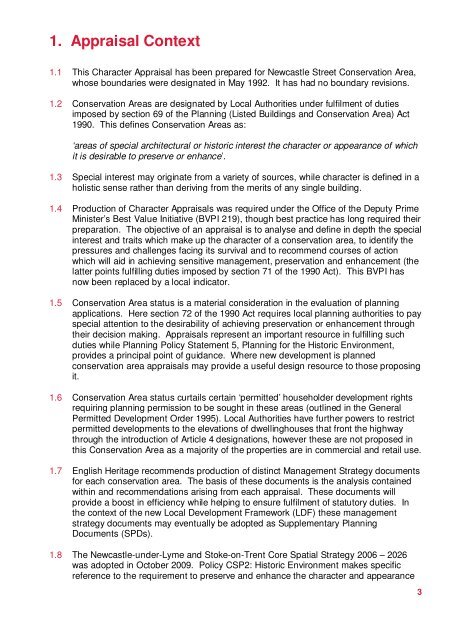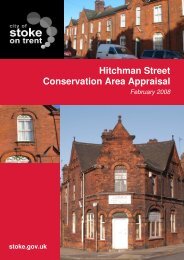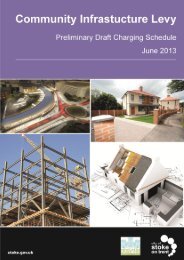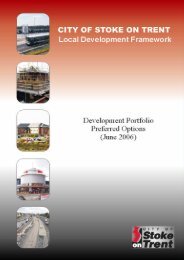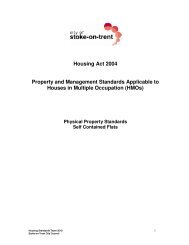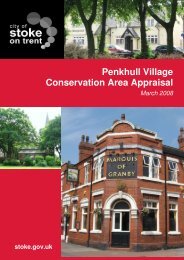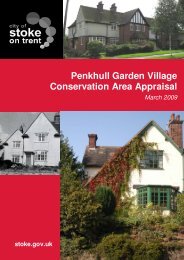Appendix B: Historic Maps of the Conservation Area
Appendix B: Historic Maps of the Conservation Area
Appendix B: Historic Maps of the Conservation Area
- No tags were found...
You also want an ePaper? Increase the reach of your titles
YUMPU automatically turns print PDFs into web optimized ePapers that Google loves.
1. Appraisal Context1.1 This Character Appraisal has been prepared for Newcastle Street <strong>Conservation</strong> <strong>Area</strong>,whose boundaries were designated in May 1992. It has had no boundary revisions.1.2 <strong>Conservation</strong> <strong>Area</strong>s are designated by Local Authorities under fulfilment <strong>of</strong> dutiesimposed by section 69 <strong>of</strong> <strong>the</strong> Planning (Listed Buildings and <strong>Conservation</strong> <strong>Area</strong>) Act1990. This defines <strong>Conservation</strong> <strong>Area</strong>s as:‘areas <strong>of</strong> special architectural or historic interest <strong>the</strong> character or appearance <strong>of</strong> whichit is desirable to preserve or enhance’.1.3 Special interest may originate from a variety <strong>of</strong> sources, while character is defined in aholistic sense ra<strong>the</strong>r than deriving from <strong>the</strong> merits <strong>of</strong> any single building.1.4 Production <strong>of</strong> Character Appraisals was required under <strong>the</strong> Office <strong>of</strong> <strong>the</strong> Deputy PrimeMinister’s Best Value Initiative (BVPI 219), though best practice has long required <strong>the</strong>irpreparation. The objective <strong>of</strong> an appraisal is to analyse and define in depth <strong>the</strong> specialinterest and traits which make up <strong>the</strong> character <strong>of</strong> a conservation area, to identify <strong>the</strong>pressures and challenges facing its survival and to recommend courses <strong>of</strong> actionwhich will aid in achieving sensitive management, preservation and enhancement (<strong>the</strong>latter points fulfilling duties imposed by section 71 <strong>of</strong> <strong>the</strong> 1990 Act). This BVPI hasnow been replaced by a local indicator.1.5 <strong>Conservation</strong> <strong>Area</strong> status is a material consideration in <strong>the</strong> evaluation <strong>of</strong> planningapplications. Here section 72 <strong>of</strong> <strong>the</strong> 1990 Act requires local planning authorities to payspecial attention to <strong>the</strong> desirability <strong>of</strong> achieving preservation or enhancement through<strong>the</strong>ir decision making. Appraisals represent an important resource in fulfilling suchduties while Planning Policy Statement 5, Planning for <strong>the</strong> <strong>Historic</strong> Environment,provides a principal point <strong>of</strong> guidance. Where new development is plannedconservation area appraisals may provide a useful design resource to those proposingit.1.6 <strong>Conservation</strong> <strong>Area</strong> status curtails certain ‘permitted’ householder development rightsrequiring planning permission to be sought in <strong>the</strong>se areas (outlined in <strong>the</strong> GeneralPermitted Development Order 1995). Local Authorities have fur<strong>the</strong>r powers to restrictpermitted developments to <strong>the</strong> elevations <strong>of</strong> dwellinghouses that front <strong>the</strong> highwaythrough <strong>the</strong> introduction <strong>of</strong> Article 4 designations, however <strong>the</strong>se are not proposed inthis <strong>Conservation</strong> <strong>Area</strong> as a majority <strong>of</strong> <strong>the</strong> properties are in commercial and retail use.1.7 English Heritage recommends production <strong>of</strong> distinct Management Strategy documentsfor each conservation area. The basis <strong>of</strong> <strong>the</strong>se documents is <strong>the</strong> analysis containedwithin and recommendations arising from each appraisal. These documents willprovide a boost in efficiency while helping to ensure fulfilment <strong>of</strong> statutory duties. In<strong>the</strong> context <strong>of</strong> <strong>the</strong> new Local Development Framework (LDF) <strong>the</strong>se managementstrategy documents may eventually be adopted as Supplementary PlanningDocuments (SPDs).1.8 The Newcastle-under-Lyme and Stoke-on-Trent Core Spatial Strategy 2006 – 2026was adopted in October 2009. Policy CSP2: <strong>Historic</strong> Environment makes specificreference to <strong>the</strong> requirement to preserve and enhance <strong>the</strong> character and appearance3


